
Psychedelic rock is a rock music genre that is inspired, influenced, or representative of psychedelic culture, which is centered on perception-altering hallucinogenic drugs. The music incorporated new electronic sound effects and recording techniques, extended instrumental solos, and improvisation. Many psychedelic groups differ in style, and the label is often applied spuriously.
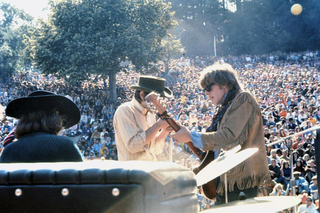
The Summer of Love was a social phenomenon that occurred during the summer of 1967, when as many as 100,000 people, mostly young people sporting hippie fashions of dress and behavior, converged in San Francisco's neighborhood of Haight-Ashbury. More broadly, the Summer of Love encompassed the culture of hippie music, hallucinogenic drugs, anti-war sentiment, and free-love throughout the West Coast of the United States, and as far away as New York City.

A hippie, also spelled hippy, especially in British English, is someone associated with the counterculture of the 1960s, originally a youth movement that began in the United States during or around 1964 and spread to different countries around the world. The word hippie came from hipster and was used to describe beatniks who moved into New York City's Greenwich Village, San Francisco's Haight-Ashbury district, and Chicago's Old Town community. The term hippie was used in print by San Francisco writer Michael Fallon, helping popularize use of the term in the media, although the tag was seen elsewhere earlier.

Paul Krassner was an American writer and satirist. He was the founder, editor, and a frequent contributor to the freethought magazine The Realist, first published in 1958. Krassner became a key figure in the counterculture of the 1960s as a member of Ken Kesey's Merry Pranksters and a founding member of the Yippies, a term he is credited with coining.
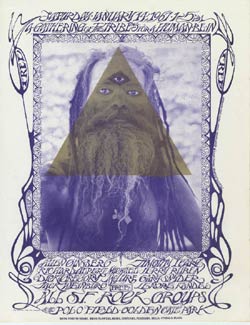
The Human Be-In was an event held in San Francisco's Golden Gate Park Polo Fields on January 14, 1967. It was a prelude to San Francisco's Summer of Love, which made the Haight-Ashbury district a symbol of American counterculture and introduced the word "psychedelic" to suburbia.
The Love Pageant Rally took place on October 6, 1966—the day LSD became illegal—in the 'panhandle' of Golden Gate Park, a narrower section that projects into San Francisco's Haight-Ashbury district. The 'Haight' was a neighborhood of run-down turn-of-the-20th-century housing that was the center of San Francisco's counterculture in the 1960s.

Haight-Ashbury is a district of San Francisco, California, named for the intersection of Haight and Ashbury streets. It is also called The Haight and The Upper Haight. The neighborhood is known as one of the main centers of the counterculture of the 1960s.

Flower child originated as a synonym for hippie, especially among the idealistic young people who gathered in San Francisco and the surrounding area during the Summer of Love in 1967. It was the custom of "flower children" to wear and distribute flowers or floral-themed decorations to symbolize ideals of universal belonging, peace, and love. The mass media picked up on the term and used it to refer in a broad sense to any hippie. Flower children were also associated with the flower power political movement, which originated in ideas written by Allen Ginsberg in 1965.

The San Francisco sound refers to rock music performed live and recorded by San Francisco-based rock groups of the mid-1960s to early 1970s. It was associated with the counterculture community in San Francisco, particularly the Haight-Ashbury district, during these years. San Francisco is a westward-looking port city, a city that at the time was 'big enough' but not manic like New York City or spread out like Los Angeles. Hence, it could support a 'scene'. According to journalist Ed Vulliamy, "A core of Haight Ashbury bands played with each other, for each other"
The Spring Mobilization Committee to End the War in Vietnam, which became the National Mobilization Committee to End the War in Vietnam, was a coalition of American antiwar activists formed in November 1966 to organize large demonstrations in opposition to the Vietnam War. The organization was informally known as "the Mobe".

The counterculture of the 1960s was an anti-establishment cultural phenomenon and political movement that developed in the Western world during the mid-20th century. It began in the early 1960s, and continued through the early 1970s. It is often synonymous with cultural liberalism and with the various social changes of the decade. The effects of the movement have been ongoing to the present day. The aggregate movement gained momentum as the civil rights movement in the United States had made significant progress, such as the Voting Rights Act of 1965, and with the intensification of the Vietnam War that same year, it became revolutionary to some. As the movement progressed, widespread social tensions also developed concerning other issues, and tended to flow along generational lines regarding respect for the individual, human sexuality, women's rights, traditional modes of authority, rights of people of color, end of racial segregation, experimentation with psychoactive drugs, and differing interpretations of the American Dream. Many key movements related to these issues were born or advanced within the counterculture of the 1960s.

The March on the Pentagon was a massive demonstration against the Vietnam War on October 21, 1967. The protest involved more than 100,000 attendees at a rally by the Lincoln Memorial. Later about 50,000 people marched across the Potomac River to The Pentagon and sparked a confrontation with paratroopers on guard. The demonstrations were highly polarizing, and also produced the famous photograph of a protester placing flowers in a paratroopers' rifle.
The hippie subculture began its development as a youth movement in the United States during the early 1960s and then developed around the world.

The Ultimate Confrontation: The Flower and the Bayonet is a photograph of Jan Rose Kasmir, at that time an American high-school student. This iconic photograph was taken by French photographer Marc Riboud. Riboud photographed Kasmir on 21 October 1967 while taking part with over 100,000 anti-war activists in the National Mobilization Committee to End the War in Vietnam's March on the Pentagon to protest U.S. involvement in Vietnam. Seventeen-year-old Kasmir was shown clasping a chrysanthemum and gazing at bayonet-wielding soldiers. The photo was featured in the December 30, 1969 special edition of Look magazine under the title The Ultimate Confrontation: The Flower and the Bayonet. The photo was republished world-wide and became a symbol of the flower power movement. Smithsonian magazine later called it "a gauzy juxtaposition of armed force and flower child innocence".
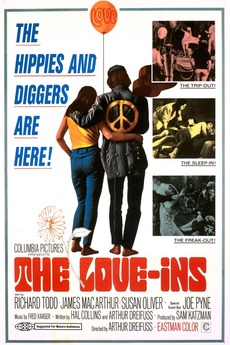
The Love-Ins is a 1967 American counterculture-era exploitation movie about LSD that was directed by Arthur Dreifuss.

The Mantra-Rock Dance was a counterculture music event held on January 29, 1967, at the Avalon Ballroom in San Francisco. It was organized by followers of the International Society for Krishna Consciousness (ISKCON) as an opportunity for its founder, A. C. Bhaktivedanta Swami Prabhupada, to address a wider public. It was also a promotional and fundraising effort for their first center on the West Coast of the United States.
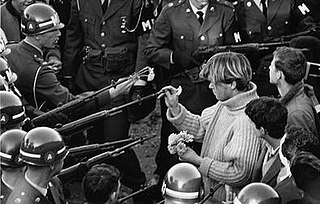
Flower Power is the title of a photograph taken by American photographer Bernie Boston for the now-defunct newspaper The Washington Evening Star. Taken on October 21, 1967, during the March on the Pentagon by the National Mobilization Committee to End the War in Vietnam, the photo shows protester George Harris placing a carnation into the barrel of an M14 rifle held by a soldier of the 503rd Military Police Battalion (Airborne).
Lee Quarnstrom was an American journalist, executive editor of Larry Flynt’s Hustler Magazine, and a Beatnik. He was a core member of the Merry Band of Pranksters, a group loosely led by novelist Ken Kesey.
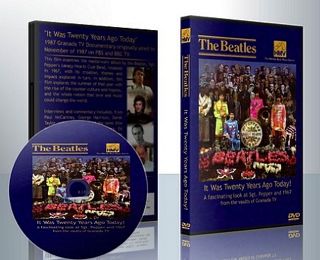
It Was Twenty Years Ago Today is a 1987 British-made television documentary film about the 1967 Summer of Love. It premiered on 1 June 1987, twenty years after the official release date of the Beatles' album Sgt. Pepper's Lonely Hearts Club Band, and presents the album as the central factor behind the events and scenes that led to the full emergence of the 1960s counterculture.
















